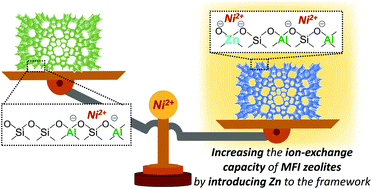当前位置:
X-MOL 学术
›
Dalton Trans.
›
论文详情
Our official English website, www.x-mol.net, welcomes your feedback! (Note: you will need to create a separate account there.)
Increasing the ion-exchange capacity of MFI zeolites by introducing Zn to aluminosilicate frameworks†
Dalton Transactions ( IF 4 ) Pub Date : 2018-06-27 00:00:00 , DOI: 10.1039/c8dt01391h Natsume Koike 1, 2, 3, 4 , Kenta Iyoki 1, 2, 3, 4 , Bangda Wang 1, 2, 3, 4, 5 , Yutaka Yanaba 2, 4, 6, 7 , Shanmugam Palani Elangovan 4, 8, 9, 10, 11 , Keiji Itabashi 4, 8, 9, 10, 11 , Watcharop Chaikittisilp 1, 2, 3, 4 , Tatsuya Okubo 1, 2, 3, 4
Dalton Transactions ( IF 4 ) Pub Date : 2018-06-27 00:00:00 , DOI: 10.1039/c8dt01391h Natsume Koike 1, 2, 3, 4 , Kenta Iyoki 1, 2, 3, 4 , Bangda Wang 1, 2, 3, 4, 5 , Yutaka Yanaba 2, 4, 6, 7 , Shanmugam Palani Elangovan 4, 8, 9, 10, 11 , Keiji Itabashi 4, 8, 9, 10, 11 , Watcharop Chaikittisilp 1, 2, 3, 4 , Tatsuya Okubo 1, 2, 3, 4
Affiliation

|
MFI zeolites exchanged with various cations have gained a great deal of attention as catalysts. Increase in the ion-exchange capacity of zeolites can improve their catalytic properties by introducing more active sites; however, the ion-exchange capacity of MFI zeolites is limited by maximum aluminum content in the structure. To improve the ion-exchange capability of the MFI zeolites beyond the upper limit of the aluminosilicate MFI zeolites, we propose herein an approach to incorporate Zn(II) in the zeolitic framework, because Zn in the framework sites generates two negative charges per atom. Using zincoaluminosilicate gels prepared via co-precipitation, organic-free synthesis of zincoaluminosilicate MFI zeolites was achieved. The obtained zincoaluminosilicate MFI zeolites had high Zn contents comparable to those in the initial zincoaluminosilicate gels with both Zn and Al in the zeolite framework. In contrast, the use of conventional sources of Si, Al, and Zn resulted in zeolites with extra-framework zinc oxide species. The obtained Zn-substituted MFI zeolites were shown to possess higher ion-exchange capacity compared to aluminosilicate MFI zeolites. It was also revealed that the zincoaluminosilicate MFI zeolites have high affinity for the divalent cation compared to the aluminosilicate analog, likely due to the two negative charges in close proximity. Because of these higher ion-exchange efficiencies, especially for divalent cations, the obtained zincoaluminosilicate MFI zeolites are expected to be efficient platforms for several important catalytic reactions.
中文翻译:

通过将锌引入铝硅酸盐骨架中来提高MFI沸石的离子交换能力†
与各种阳离子交换的MFI沸石作为催化剂已引起了广泛的关注。沸石离子交换能力的提高可以通过引入更多的活性位点来改善其催化性能。但是,MFI沸石的离子交换能力受到结构中最大铝含量的限制。为了提高MFI沸石的离子交换能力,使其超过铝硅酸盐MFI沸石的上限,我们在此提出一种将Zn(II)掺入沸石骨架的方法,因为在骨架位点中的Zn每个原子产生两个负电荷。使用通过制备的铝硅酸锌凝胶共沉淀,无有机合成锌铝硅酸锌MFI沸石。所获得的铝硅酸锌MFI沸石具有高的Zn含量,可与在沸石骨架中同时具有Zn和Al的初始铝硅酸锌凝胶中的锌含量相比。相反,使用常规来源的Si,Al和Zn导致沸石具有骨架外的氧化锌物质。与铝硅酸盐MFI沸石相比,显示出所获得的Zn-取代的MFI沸石具有更高的离子交换能力。还显示出,与铝硅酸盐类似物相比,铝硅酸锌MFI沸石对二价阳离子具有高亲和力,这可能是由于两个负电荷非常接近。由于这些离子交换效率更高,尤其是对于二价阳离子,
更新日期:2018-06-27
中文翻译:

通过将锌引入铝硅酸盐骨架中来提高MFI沸石的离子交换能力†
与各种阳离子交换的MFI沸石作为催化剂已引起了广泛的关注。沸石离子交换能力的提高可以通过引入更多的活性位点来改善其催化性能。但是,MFI沸石的离子交换能力受到结构中最大铝含量的限制。为了提高MFI沸石的离子交换能力,使其超过铝硅酸盐MFI沸石的上限,我们在此提出一种将Zn(II)掺入沸石骨架的方法,因为在骨架位点中的Zn每个原子产生两个负电荷。使用通过制备的铝硅酸锌凝胶共沉淀,无有机合成锌铝硅酸锌MFI沸石。所获得的铝硅酸锌MFI沸石具有高的Zn含量,可与在沸石骨架中同时具有Zn和Al的初始铝硅酸锌凝胶中的锌含量相比。相反,使用常规来源的Si,Al和Zn导致沸石具有骨架外的氧化锌物质。与铝硅酸盐MFI沸石相比,显示出所获得的Zn-取代的MFI沸石具有更高的离子交换能力。还显示出,与铝硅酸盐类似物相比,铝硅酸锌MFI沸石对二价阳离子具有高亲和力,这可能是由于两个负电荷非常接近。由于这些离子交换效率更高,尤其是对于二价阳离子,


























 京公网安备 11010802027423号
京公网安备 11010802027423号